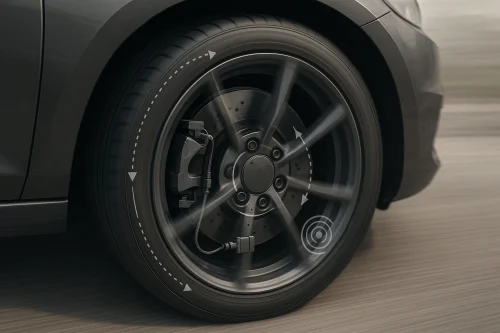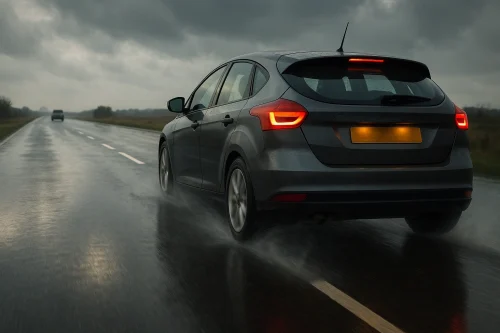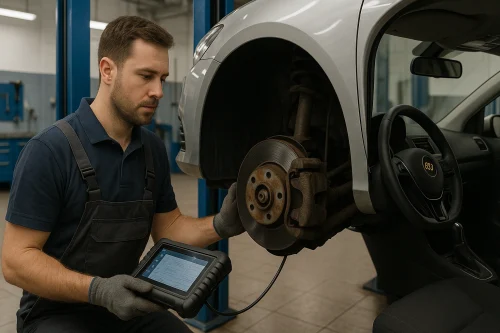Table of Contents
It’s a rainy Thursday morning in Manchester. You’re driving to work when, out of nowhere, a van in front of you slams on the brakes. You react instinctively and hit your own brakes hard, but what happens next depends entirely on how well you understand and use your anti-lock braking system (ABS).
Many drivers have ABS in their vehicles but don’t fully know how to use it in real emergencies. The reality is, ABS can significantly increase your chances of maintaining control during sudden stops, but only when it’s used correctly.
In this article, we’ll explore everything UK drivers need to know about using anti-lock brakes during an emergency stop. We’ll cover how ABS works, the correct braking technique, mistakes to avoid, and how to practise so you’re ready when the unexpected happens.
What Is an Anti-Lock Braking System (ABS)?

An Anti-lock Braking System (ABS) is a crucial safety feature found in most modern cars, vans, and motorcycles. Its primary purpose is to prevent the wheels from locking up during heavy or emergency braking.
When a vehicle’s wheels lock, it can lose traction with the road. This makes steering difficult or impossible and can lead to skidding, particularly on wet or icy roads. ABS prevents this by automatically adjusting brake pressure, allowing the wheels to keep turning, even under forceful braking.
Here’s how it works in brief: each wheel is fitted with speed sensors. When the system detects that one or more wheels are about to lock, it rapidly reduces and reapplies brake pressure, sometimes 15 times per second. This action maintains traction and allows the driver to retain steering control.
Why Is ABS Important in Emergency Situations?
In emergency scenarios, milliseconds matter. A locked wheel can send a car into a skid, reducing the driver’s ability to manoeuvre or stop effectively. ABS helps you brake hard without losing control, especially when sudden hazards appear on the road.
Consider a motorway scenario. A driver suddenly brakes due to a pile-up ahead. Without ABS, a car behind may lock its wheels and slide, even while braking. With ABS, the driver can hit the brakes fully, keep the wheels turning, and even steer to avoid an obstacle.
In everyday driving across the UK, from city traffic in Birmingham to rural roads in Northumberland, ABS offers a significant safety advantage during unplanned stops.
How Should You Use ABS When You Need to Stop Suddenly?

Using ABS correctly in an emergency is straightforward but must be done properly. Here’s the recommended approach:
Apply firm, continuous pressure to the brake pedal using your right foot. Do not ease off, and do not pump the pedal, ABS takes care of that automatically. Keep your foot on the brake until the vehicle comes to a full stop.
At the same time, maintain control of the steering wheel. ABS allows you to steer while braking hard, something that isn’t possible with locked wheels. If there’s a hazard in your lane, you can guide the vehicle around it safely.
You may feel a pulsing sensation in the brake pedal and hear a mechanical grinding or vibrating noise. This is completely normal and indicates that the ABS is functioning correctly. Your job is simply to stay calm, steer where needed, and keep pressure on the pedal.
What Should You Avoid Doing While Braking With ABS?
Even though ABS is a helpful system, it’s not magic. Its effectiveness depends on how the driver responds in the moment. There are several common errors that can reduce its effectiveness:
- Pumping the Brakes: This is an old habit from pre-ABS days. If you do this with ABS, you’ll confuse the system and potentially allow the wheels to lock.
- Lifting Off the Pedal: Some drivers instinctively let up on the brake when they feel the pedal vibrating. Doing so disables ABS, often at the worst moment.
- Jerking the Steering Wheel: While you can steer with ABS, sudden or excessive movements may destabilise the vehicle, especially on slippery surfaces.
- Panicking at Noises: The sound and feel of ABS can be surprising. Grinding noises and pedal feedback are normal, resist the urge to react.
It’s vital to trust the system. ABS is engineered to help you stay in control, but only if you allow it to work as designed.
How Does ABS Feel When It’s Working?
When ABS engages, drivers often think something has gone wrong. In reality, the system behaves in ways that are unusual but perfectly normal.
You might experience a strong vibration or pulsing under your foot. This is the ABS rapidly adjusting brake pressure to prevent wheel lock-up. Some cars produce clicking or grinding noises, and the brake pedal might resist slightly or drop further than expected.
These sensations are signs the system is working correctly. They can be startling the first time, which is why practising ABS braking in a controlled environment is strongly encouraged for all drivers.
Can You Steer While Braking With ABS?

Yes, and this is one of the most important advantages of ABS. With traditional brakes, once the wheels lock, steering becomes virtually impossible. The tyres are no longer gripping the road, and the car will likely slide straight ahead, regardless of where you turn the wheel.
ABS keeps the wheels turning, which keeps traction on the road surface. This allows the driver to maintain directional control. For example, if a child runs into the street, you can brake heavily and steer safely around them without losing control.
This is particularly helpful in wet or icy UK driving conditions, where steering input during a skid can otherwise cause spins or accidents.
How Does ABS Perform on Different Road Surfaces?
ABS generally improves safety across most surfaces, but its performance varies depending on the road type and condition.
|
Road Surface |
ABS Performance |
|
Dry Tarmac |
Very effective. Shorter stopping distance and full control. |
|
Wet Roads |
Highly effective. Prevents hydroplaning and skidding. |
|
Icy or Snow-Covered |
Steering control is improved, but stopping distance may increase. |
|
Gravel or Loose Dirt |
May slightly increase stopping distance but offers far more directional stability. |
|
Urban Paved Streets |
Excellent control and quick response during short-distance braking. |
|
Rural or Uneven Roads |
Improves control but still requires caution due to surface variability. |
While ABS enhances braking safety, it is not a substitute for safe speeds and cautious driving, especially in adverse weather.
Can You Practise Emergency Braking With ABS?
Yes, and doing so is strongly encouraged, especially for drivers who’ve never felt ABS in action.
The best way to practise is in a controlled, safe environment, such as:
- An empty car park free of pedestrians and obstacles
- A driver training facility offering emergency braking courses
- During advanced driving lessons, which often include ABS familiarisation
Practising allows you to experience how the pedal feels when ABS activates. It also helps condition your responses, so you won’t panic or ease off the pedal when the system kicks in.
How Do ABS and Traditional Brakes Compare in Emergencies?
The contrast between traditional braking systems and ABS is significant when sudden braking is required. Below is a table summarising key differences:
|
Feature |
ABS Brakes |
Traditional Brakes |
|
Wheel Lock Prevention |
Yes |
No |
|
Steering While Braking |
Possible |
Very limited or impossible |
|
Pedal Pulsing |
Normal, part of ABS function |
No |
|
Braking Technique |
Firm, continuous pressure |
Pumping required to avoid wheel lock |
|
Stopping Distance |
Generally shorter (on wet/dry roads) |
Often longer due to skidding |
|
Suitable for Emergency Stops |
Highly suitable |
Less reliable, especially on slippery roads |
Understanding these differences is key for driving safely in modern vehicles.
How Can You Ensure Your ABS Is Working Properly?

Like all systems, ABS must be properly maintained to function when you need it most. Fortunately, modern cars offer clear indicators when something’s wrong.
If the ABS warning light on your dashboard stays on after the vehicle starts, it signals a problem. While normal braking will still work, the ABS function may be disabled. In this case, book a service as soon as possible.
It’s also important to:
- Include ABS checks during regular vehicle servicing
- Monitor your brake fluid levels
- Replace worn brake pads or sensors when advised
- Keep your tyres properly inflated and with legal tread depth
Routine maintenance ensures your car’s safety systems are ready when required, not just ABS, but the entire braking system.
What Should You Remember About Using ABS in an Emergency?
In an emergency, every second counts. By using ABS correctly, you increase your chances of avoiding an accident while staying in control of your vehicle.
Here’s what matters most:
- Apply firm, steady pressure on the brake pedal.
- Do not pump the brakes.
- Keep steering under control, and avoid overreacting.
- Trust the system, even if the sounds and sensations are unfamiliar.
When used properly, ABS can be the difference between a near-miss and a serious collision. Understanding how it works, and how to use it instinctively, is essential for safe driving in the UK.
Frequently Asked Questions
Can ABS stop a car faster than traditional brakes?
In many situations, yes. Especially on wet or slippery roads, ABS prevents skidding and often results in shorter stopping distances.
Is it safe to steer while braking with ABS?
Yes. One of the major advantages of ABS is that it allows you to steer while applying full braking force.
What should I do if my ABS warning light stays on?
You should have your car inspected as soon as possible. The light indicates a potential fault in the ABS system.
Should I practise ABS braking?
Absolutely. Practising helps you become familiar with how the system feels and builds your confidence during real emergencies.
Does ABS work the same on ice or snow?
ABS improves control but may increase stopping distances on slick surfaces. Drive more slowly and leave more space when road conditions are poor.
Can ABS fail during driving?
While rare, failures can happen due to electrical or sensor issues. Regular maintenance helps prevent this.
Is pumping the brakes ever appropriate?
Only in vehicles without ABS. If your car has ABS, you should apply steady pressure and let the system do the work.




